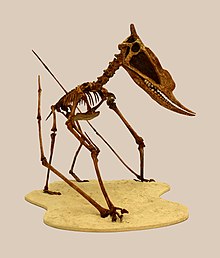1964 in paleontology
| |||
|---|---|---|---|
| +... |
Paleontology or palaeontology is the study of prehistoric life forms on Earth through the examination of plant and animal fossils.[1] This includes the study of body fossils, tracks (ichnites), burrows, cast-off parts, fossilised feces (coprolites), palynomorphs and chemical residues. Because humans have encountered fossils for millennia, paleontology has a long history both before and after becoming formalized as a science. This article records significant discoveries and events related to paleontology that occurred or were published in the year 1964.
Arthropods
Newly named insects
| Name | Novelty | Status | Authors | Age | Unit | Location | Notes | Images |
|---|---|---|---|---|---|---|---|---|
|
Comb nov |
Syn |
Late Eocene |
A Dolichoderin ant |
 |
Mollusca
Newly named bivalves
| Name | Novelty | Status | Authors | Age | Location | Notes | Images |
|---|---|---|---|---|---|---|---|
|
Gen et sp nov |
Valid |
Soot-Reyn |
New genus and species with five other species moved from other genera |
Archosauromorphs
Newly named dinosaurs
Data courtesy of George Olshevsky's dinosaur genera list.[4]
| Name | Status | Authors | Age | Unit | Location | Notes | Images | |
|---|---|---|---|---|---|---|---|---|
| Chilantaisaurus[5] | Valid taxon |
|
Late Cretaceous (Turonian) |
A member of Neovenatoridae. |
 | |||
| Eustreptospondylus[6] | Valid taxon |
Middle Jurassic (Callovian) |
A megalosaurid. |
 | ||||
| Fabrosaurus[7] | Nomen dubium. |
Early Jurassic (Sinemurian-Pliensbachian) |
A dubious ornithischian. |
|||||
| Metriacanthosaurus[6] | Valid taxon |
Late Jurassic (Oxfordian) |
A member of Metriacanthosauridae. |
 | ||||
Newly named birds
| Name | Novelty | Status | Authors | Age | Unit | Location | Notes | Images |
|---|---|---|---|---|---|---|---|---|
|
Sp. nov. |
Valid |
A Meleagridae. |
||||||
|
Sp. nov. |
Valid |
An Anatidae. |
||||||
|
Sp. nov. |
Valid |
Howard |
Late Pleistocene |
|
A Strigidae. |
|||
|
Sp. nov. |
jr synonym |
Brodkorb |
An Anatidae, transferred to Anas greeni. |
|||||
|
Gen et Sp. nov. |
jr synonym? |
|
A Pseudodontornithidae, type species T. wetmorei, |
Pterosaurs
New taxa
|
| ||||||||||||||||||||||||
Plesiosaurs
New taxa
|
| |||||||||||||
Other animals
Other newly named animals
| Name | Novelty | Status | Authors | Age | Unit | Location | Notes | Images |
|---|---|---|---|---|---|---|---|---|
|
Gen et Sp. nov. |
Valid |
Cooper |
Late Cretaceous (Campanian) |
A tardigrade; originally placed in its own family (Beornidae), it was later reclassified as a member of the Hypsibiidae.[14] |
 |
References
- ^ Gini-Newman, Garfield; Graham, Elizabeth (2001). Echoes from the past: world history to the 16th century. Toronto: McGraw-Hill Ryerson Ltd. ISBN 9780070887398. OCLC 46769716.
- ^ Antropov AV, Belokobylskij SA, Compton SG, Dlussky GM, Khalaim AI, KolyadaVA, Kozlov MA, PerfilievaKS, Rasnitsyn AP (2014). "The wasps, bees and ants (Insecta: Vespida=Hymenoptera) from the Insect Limestone (Late Eocene) of the Isle of Wight, UK" (PDF). Earth and Environmental Science Transactions of the Royal Society of Edinburgh. 104 (3–4): 335–446. doi:10.1017/S1755691014000103. S2CID 85699800.
- ^ Cope, J.C.W. (1999). "Middle Ordovician bivalves from Mid-Wales and the Welsh Borderland". Palaeontology. 42 (3): 467–499. Bibcode:1999Palgy..42..467C. doi:10.1111/1475-4983.00081.
- ^ Olshevsky, George. "Dinogeorge's Dinosaur Genera List". Archived from the original on 2011-07-15. Retrieved 2008-08-07.
- ^ Hu S. 1964. Carnosaurian remains from Alashan, Inner Mongolia. Vertebrata PalAsiatica 8: pp. 42-63.
- ^ a b Walker, A.D. 1964. Triassic Reptiles from the Elgin area: Ornithosuchus and the origin of Carnosaurs. Philosophical Transactions of the Royal Society of London, series B 248: pp. 53- 135.
- ^ Ginsburg, L. 1964. Decouverte d'un Scelidosaurian (Dinosaure ornithischien) dans le Trias superieur du Basutoland. Compte rendu hebdomadaire des seances de l’Academie des Sciences Paris, tomo 258: pp. 2366-2368.
- ^ Brodkorb, P (1964). "Notes of Fossil Turkeys" (PDF). Quarterly Journal of the Florida Academy of Sciences. 27 (3): 223–229. Archived from the original (PDF) on 2014-12-16. Retrieved 2014-12-13.
- ^ Howard, H (1964). "A New Species of "Pygmee Goose," Anabernicula, from the Oregon Pleistocene, with a Discussion of the genus" (PDF). American Museum Novitates (2200): 1–14.
- ^ Howard, H (1964). "A fossil owl from Santa Rosa Island" (PDF). Bulletin of the Southern California Academy of Sciences. 163: 27–31. Archived from the original (PDF) on 2016-03-03. Retrieved 2014-12-13.
- ^ Brodkorb, P (1964). "A Pliocene Teal from South Dakota". Quarterly Journal of the Florida Academy of Sciences. 27 (1): 55–58.
- ^ Hopson, JA (1964). "Pseudodontornis and Other Large Marine Birds from the Miocene of South Carolina" (PDF). Postilla, Peabody Museum of Natural History, Yale University. 83: 1–19. Archived from the original (PDF) on 2014-03-04. Retrieved 2014-12-05.
- ^ Cooper, Kenneth W. (1964-01-01). "The first fossil tardigrade: Beorn leggi Cooper, from Cretaceous amber". Psyche: A Journal of Entomology. 71 (2): 41–48. doi:10.1155/1964/48418. ISSN 0033-2615.
- ^ Mapalo, Marc A.; Wolfe, Joanna M.; Ortega-Hernández, Javier (2024-08-06). "Cretaceous amber inclusions illuminate the evolutionary origin of tardigrades". Communications Biology. 7 (1). doi:10.1038/s42003-024-06643-2. ISSN 2399-3642. PMC 11303527.


